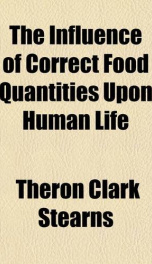the influence of correct food quantities upon human life

Purchase of this book includes free trial access to www.million-books.com where you can read more than a million books for free. This is an OCR edition with typos. Excerpt from book: SYSTEMATIC CALCULATION OF FOOD VALUES In the laboratory any system of weights and measures may be used, with equal facility. For common use, two systems have been proposed, one by Kellog in which the calculation is made in values of calories per ounce. The other, proposed by Fisher is based upon calories per centum and the somewhat indefinite "food portion." Values given in most tables are in calories per pound, which, for purposes of general comparison, are as useful as any. For the purpose of universal application of the principles involved, it is necessary to make use of factors, knowledge concerning which can be easily acquired; figures concerning which can be easily remembered, of which the one for each food must be for a quantity approaching as closely as possible to quantities most commonly handled. These conditions are best met by the use of the metric system, because it is a decimal system, and, therefore, easy to divide or multiply mentally. For the same reason the expression of food values for quantities of 100 grams is best adapted to the purpose. It is as easy to remember the figure value of 100 grammes of food as it is to remember the figure of values for one pound, or one ounce. It is found easier to estimate, without scales, after a little practice, the weight of portions of food, if the metric system is used, and if the value is calculated in quantities of 100 grams. To utilize the available knowledge of the subject, one has only to practice weighing food as supplied at the table for a brief periodtwo weeks is usually ample when it will be found easy to estimate, with sufficient accuracy for the purpose, the weight of any given quantity of food without the use of scales, or weights; in the course of this experience, one will have automatically memor...
Users who have this book
Users who want this book
What readers are saying
What do you think? Write your own comment on this book!
write a commentif you like the influence of correct food quantities upon human life try:
Other books by this author
Do you want to read a book that interests you? It’s EASY!
Create an account and send a request for reading to other users on the Webpage of the book!


